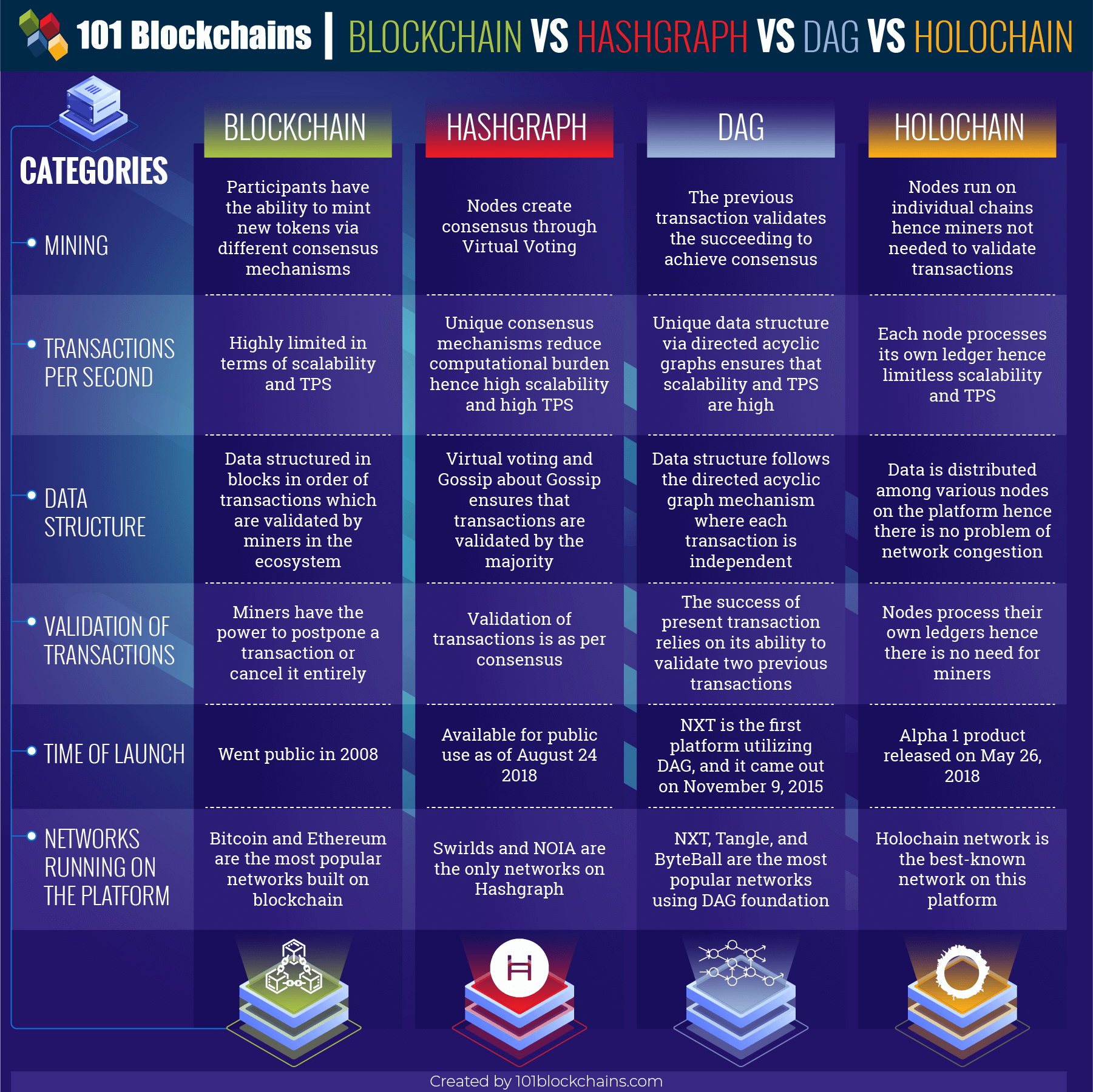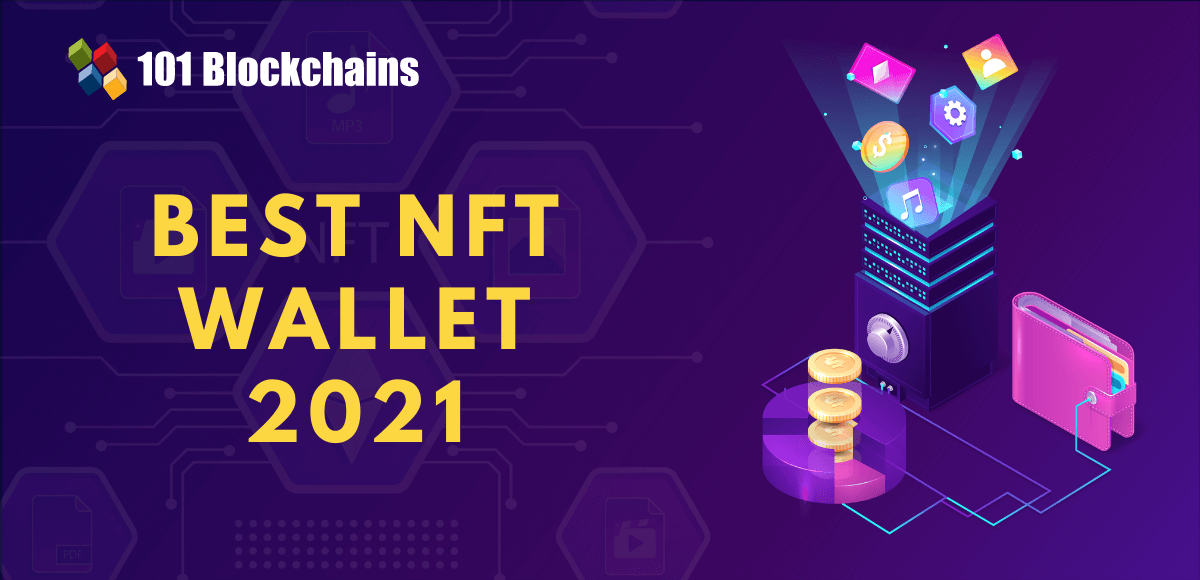Learn how blockchain truly works, master key definitions, and uncover what makes smart contracts so "smart." Dive into the fundamentals, gain valuable insights, and start your blockchain journey today!

- Reviews
Gwyneth Iredale
- on February 16, 2021
Blockchain vs Hashgraph vs Dag vs Holochain: Types of DLTs
This article discusses the types of distributed ledger technologies and does a detailed comparison of Blockchain vs Hashgraph vs DAG vs Holochain.
Blockchain technology has completed a decade in existence. Interesting as it has been, the first ten years have brought to the surface new and interesting sources of investment with some enthusiasts making to the billionaires rich list just overnight.
However, the most exhilarating highlight of the last ten years of cryptocurrencies is the distributed ledger technology (DLT) that underlies digital currencies.
Build your identity as a certified blockchain expert with 101 Blockchains’ Blockchain Certifications designed to provide enhanced career prospects.
How Did the Concept of Distributed Technology Come to Being?
Blockchain first hit popular headlines in the immediate aftermath of bitcoin, the very first digital currency. The last decade is witness to interesting developments where distributed ledger technology or blockchain in other terms found numerous use cases besides powering cryptocurrencies.
However, systemic inefficiencies and scaling problems led to developers looking for solutions outside the blockchain. As such, there are novel and ingenious developments like Holochain, Directed Acyclic Graph (DAG), and Hashgraph. In essence, the gist is to keep the original purpose of blockchain alive in the face of new and unforeseen difficulties.
The advent of the new solutions, which majorly differ from blockchain-based on data structures, has brought other fundamental and yet significant discussions regarding which network is the best. In this light, this paper intends to dissect the networks and bring to the fore their various strengths and limitations.
In particular, the article will compare Blockchain vs Hashgraph vs DAG vs Holochain. As such, the hope is that the reader can, once and for all, be in a position to settle the debate surrounding the networks’ significance.
Get familiar with the terms related to blockchain with Blockchain Basics Flashcards.
Comparison of Different Types of DLTs
Please include attribution to 101blockchains.com with this graphic. <a href='https://101blockchains.com/blockchain-infographics/'> <img src='https://101blockchains.com/wp-content/uploads/2018/12/Blockchain-vs-Hashgraph-vs-Dag-vs-Holochain_1.png' alt='Blockchain vs Hashgraph vs Dag vs Holochain='0' /> </a>
Blockchain
In the white paper that brought bitcoin to the world, the author(s) noted that a network would collect transaction information in blocks. Other blocks would built onto each other forming a chain of blocks, hence blockchain.
Interestingly, each block produces a unique hash which identifies the transaction. As such, if one attempted to alter details of the transaction, a totally different hash will be generated. This will be evidence of a corrupted and invalid transaction.
On the other hand, the transactions are published on a public ledger to which every node (participant) on the network has access. Essentially, this distributed nature of the public ledger makes it even more difficult for parties to alter information. Further, this also makes it possible for transactions to happen under strict transparency.
These qualities of transparency and immutability (integrity) are notable major revolutionary aspects of blockchain features. Further, this ability to incorporate integrity and transparency in data storage and transactions is the biggest reason blockchain is disrupting many industries.
Interestingly, blockchain is not as new a concept as we might think. The mention of its fundamental structure and operation dates back over 27 years ago — when blockchain was invented. However, bitcoin the other cryptocurrencies cast a new light onto the groundbreaking technological innovation.
It is worth noting that these same cryptocurrencies created the need for solutions surrounding blockchain. This marked the beginning of new distributed ledger technology networks like Holochain, DAG and Hashgraph.
As mentioned earlier, at the heart of the new networks is the need to create a highly scalable network. Further, the networks seek to achieve higher transactions per second (TPS) capability.
Want to become a certified blockchain professional? Enroll Now: Certified Enterprise Blockchain Professional (CEBP)
Hashgraph
Hashgraph is a type of distributed ledger technology whose foundation lies in the consensus building. In particular, the DLT relies on consensus timestamping to make sure that transactions on the network agree with each and every node on the platform. The consensus algorithm brings out the robustness and superiority of the distributed ledger technology network.
Unlike the traditional distributed ledger technology network, this type of DLT builds achieves transaction success solely via consensus. This is to say that nodes to not have to validate the transactions that take place on the network. As such, users do not have to present proof of work (PoW).
This aspect eliminates the need for two things. First, traditional blockchains which rely on proof of work need many computations to achieve transaction success. As a result, this factor makes transactions bulky which achieves a very low number of TPS.
On the contrary, Hashgraph only requires the nodes on the network to achieve consensus through Gossip about Gossip technique and virtual voting technique. Interestingly, these techniques do not require proof of work to validate transactions. As a result, there is little time between initiation and completion of a transaction.
Subsequently, the lack of need for proof of work in the DLT network means that there can be thousands of TPS. Interestingly, the team behind Hashgraph claim the network can achieve more than 250,000 TPS.
With the virtual voting and gossip about gossip techniques, nodes on the Hashgraph DLT are able to experience fairness. In particular, consensus timestamping avoids issue of blockchain like canceling transactions or by putting them on future blocks.
Want to become an expert in Hedera Network Services? Enroll Now in Hedera Fundamentals Course!
Directed Acyclic Graphs (DAG)
Hashgraph is not the only effort to correct the limitations of blockchain. Like earlier mentioned, developers are focusing on the data structure of distributed ledger technology networks that affect their effectiveness. In this similar manner, directed acyclic graphs (DAG) employs a different data structure that brings about more consensus.
In particular, DAG is a type of distributed ledger technology that relies on consensus algorithms. Consensus algorithms operate in a way that transactions that prevail simply require majority support within the network. In such a network, there is much more cooperation, teamwork and nodes have equal rights.
Unlike traditional blockchain technologies where proof of work is key, DAG ensures that there is fairness. This kind of fairness gives the impression that the network sticks to the initial aim of distributed ledger technology. Particularly, the main intention of a DLT was to democratize the internet economy.
For instance, a private blockchain network relies on a centralized leadership which takes out the democracy from the DLT. On the contrary, this type of distributed ledger technology gives equal significance to each and every node existent in the network. Therefore, this means that each node does not have to refer to another node.
Already, there are projects like ByteBall that are using the DAG structure to create new generation networks free of limitations of traditional blockchain — what is ByteBall. One of the most notable “new generation” networks employing the DAG data structure is IOTA’s Tangle.
Here, the miners/nodes can perform the dual duties where nodes in blockchain perform separately. This is to say that a miner on Tangle can issue a transaction and validate a transaction at the same time.
Start your blockchain journey Now with the Enterprise Blockchains Fundamentals
Holochain
This type of distributed ledger technology boasts that it is what comes after blockchain technology. Despite the high dose of rhetoric in their bold statements, the Holochain team really has some solid propositions that rival other platforms. In particular, Holochain is after completely revolutionizing the internet as we know it.
One of the interesting visions of Holochain is to change the present structure of the internet. The internet today is structured alongside a server-client basis. This is to say that decentralization is not optimum. Further, there is little democracy and freedom regarding the utilization of the resource.
In light of this, Holochain wants to create a distributed network that can also be the basis of the “next-generation internet.” According to the platform’s whitepaper, Holochain is an amalgamation of blockchain, BitTorrent, and Github. This is to say that this is a DLT that distributes among nodes to avoid any instance of centralized control of the flow of data.
A distributed platform simply implies that each node will run on a chain of its own. This is to say that nodes or miners have the freedom to operate autonomously. In what the team behind Holochain calls distributed hash table (DHT), users can store data using certain keys. However, this data stays in actual locations “distributed” in various locations across the globe.
Advantages of Holochain
The interesting part of this data structure is that the network does not experience the burden of congestion common on a traditional blockchain. This “distributedness” of the locations that store data relieves the network and gives it more space for scalability. As such, transactions over this network can easily attain millions of TPS.
Scalability is a huge problem that is dogging both the public and the private blockchain platforms. For instance, developers usually run into huge hurdles while creating decentralized applications (dApps) on the traditional blockchain. This is because they need validation from the huge community present on the platform.
On the contrary, a developer on the Holochain platform will only need confirmation from the single chain that makes up the whole DLT network. As such, there is an insubstantial wait time between request and confirmation in this type of distributed ledger technology.
Curious to learn about blockchain implementation and strategy for managing your blockchain projects? Enroll Now in Blockchain Technology – Implementation And Strategy Course!
Comparison of DLTs
Distributed ledger technology is not new per se. Like earlier discussed, the technology has come such a long way that there are already modifications and alternatives. Further, it is clear that blockchain is the very first DLT to launch into the public space. This is despite the first description of blockchain to appear almost three decades ago.
By virtue of breaking the ground of the innovative new way to store, share and do many other things with data, blockchain takes the forerunner spot in the distributed ledger technology networks race. As such, the paragraphs that follow will compare blockchain vs other DLT networks.
Blockchain vs Hashgraph
It is obvious that blockchain and Hashgraph has many similarities since they serve a similar purpose. Essentially, they are all a type of distributed ledger technology that seeks to introduce novel monetary systems. In particular, they are all peer-to-peer such that transactions do not require a central authority to regulate them.
Also, the DLTs operate on a consensus-based system where transactions have to satisfy the participants within the network. This need for consensus is reason why transactions on these networks are transparent and flexible. Further, the high security from the cryptographic nature of the networks ensure high data security.
Nonetheless, blockchain differs from Hashgraph in more fundamental ways. Particularly, Hashgraph is a response to major limitations of blockchain like scalability and transactions rates. These particular, limitations are responsible for the limited applications of the DLT.
Hashgraph mainly differs from blockchain when it comes to the consensus mechanism. On the one hand, blockchain mainly relies on the activities of the miners within the network to facilitate the process of transactions. This is to say that a miner can greatly affect the success of a transaction singlehandedly.
Particularly, blockchain relies on the proof of work which miners can use to verify if a transaction is genuine. As such, transaction rates are slow and expensive. Further, the proof of work implies that the network comes under a huge burden of bulky computations that impose network drags.
On the other hand, Hashgraph employs a consensus mechanism that does not give too much powers to miners. On the contrary, the DLT uses consensus algorithms called Gossip about gossip and virtual voting to decide which transaction succeeds. This way, the majority have the say on which transaction to go through. As such, there is much more fairness when it comes to Hashgraph as compared to blockchain.
Start learning Blockchain with World’s first Blockchain Skill Paths with quality resources tailored by industry experts Now!
Blockchain vs DAG
Like blockchain, DAG facilitates transactions and that one cannot “walk the transactions back” to an earlier step. In particular, the word acyclic in directed acyclic graph implies that operations are strictly one directional. Similarly, immutability is one aspect that makes blockchain popular over previously existing means of data storage.
Further, both platforms operate via a consensus-based system where nodes decide what happens. As such, there is some semblance of democracy as compared to platforms that go through a central command. Unfortunately, that is as far as the similarities go.
Like Hashgraph, DAG fundamentally differs from blockchain when it comes to data structure. Like earlier discussed, blockchain arranges transactions in blocks such that each body of information pertaining to a particular transaction make up a single block. Therefore, succeeding transactions result in new blocks.
On the contrary, DAG completely does with blocks. Under DAG, the previous transaction has stronger relationship to the succeeding transaction. For instance, if you had three transactions, X, Y and Z, you will need transaction X for Y for to go through. Similarly, transaction Y validates transaction Z.
For a transaction to succeed on the DAG network, it has to validate only two of the previous transactions. This is to say that the transaction will only need to ensure that two of the previous transactions do not contain conflicting information. Interestingly, this differs greatly from blockchain where a transaction has to validate numerous transactions before being valid.
This is to say that a transaction takes more time to settle. Further, as blocks in blockchain multiply, it becomes increasing difficult in terms of computations to achieve new blocks. As such, mining gets more power intensive, hence expensive. On the other hand, transactions in DAG network adds throughput as many more validations happen.
Blockchain vs Holochain
In comparison of DLT, looking at the fundamental structure of Holochain and blockchain brings various differences to the fore. In particular, the two differ largely based on their structure although the purpose has some similarities. Interestingly, Holochain is some kind of revolutionary technology that seeks to turn everything on its head.
Like blockchain, Holochain seeks to allow secure and transparent transactions among players on the network. Information on both platforms is cryptographically secure and one cannot alter the information. Further, both platforms allow users to interact on a peer-to-peer basis. This way, they can interact directly and without need of a central authority.
Is Holochain Better?
Nonetheless, Holochain is somewhat next level compared to blockchain. Essentially, Holochain seeks to introduce a new dynamic far different from the fundamental aim of blockchain. Blockchain seeks to decentralize transactions such that people can interact directly without need for a middle-party. On the contrary, Holochain wants to make the interactions distributed.
Holochain creates a network composed of various distributed ledger technology networks. Therefore, the DLT is one major network that is limitless in terms of scalability and the number of transactions users can accomplish in a second.
On blockchain network, nodes rely on the single network to initiate and validate transactions. As such, as more blocks join the chain, computational burden multiplies as well as the fees associated with transactions. On the contrary, nodes in Holochain run on their own chains. Therefore, there is more room for computations.
The fact that each node runs on its own chain in Holochain imply that there is no need for miners. As such, transaction fees are almost non-existent. Further, this implies that there is no tokenization on the platform but rather smart contracts rule the space.
Nodes running on their own chains imply that they will be able to process ledgers that solely belong to them. This way, the relationship between various nodes on the network is trusted completely. Further, dApps have an infinite space to operate in. as such, one can expect the dApps to operate at their optimum at all instances.
Start learning Blockchain with World’s first Blockchain Career Paths with quality resources tailored by industry experts Now!
Summary/Closing Remarks
Comparison of DLT in Blockchain vs Hashgraph vs Dag vs Holochain brings out interesting aspects of platform. As much as there are obvious similarities among the DLTs, differences also stick out. Interestingly, it is apparent that blockchain was around even before the bitcoin whitepaper developed by the pseudonymous Satoshi Nakamoto.
Blockchain first gained mention in a paper that sought to find a way to protect intellectual property by timestamping documents. However, the DLT gained currency in the aftermath of bitcoin’s fame. With popularity came various unforeseen problems like scalability and TPS. Even as blockchain strives to correct the limitations, other projects are entirely creating new type of distributed ledger technology.
From the foregoing, it is apparent that all DLTs share the common aspects of transparency, consensus, transactional, distributed, peer-to-peer and flexible. However, huge differences emerge in the consensus mechanism and the structure of data within each DLT.
*Disclaimer: The article should not be taken as, and is not intended to provide any investment advice. Claims made in this article do not constitute investment advice and should not be taken as such. 101 Blockchains shall not be responsible for any loss sustained by any person who relies on this article. Do your own research!







1 Comment
Great work – bravo !